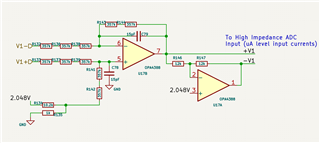Other Parts Discussed in Thread: OPA4388, , OPA333, OPA388, OPA387, OPA4376, OPA189, OPA187, OPA188, OPA186, OPA182
I'm working on an update to a design that uses the OPA4388, hoping to use OPA4387 as an upgrade but i am running into an issue.
After replacing an OPA4388 on several test boards with OPA4387, I'm measuring an unacceptable amount of non-linearity on the output of the OPA4387. With the 4388, it's linear to within my ability to measure (<10uV at best estimation). With the 4387, I'm measuring diffamp output non-linearity (with respect to input) of ~1mV (~590uV differential at the inputs). This is verified across 4 separate 4387 chips on 4 separate boards.
Input common Mode for this test is from +0.11V to +2.11V, output from +0.182 to 3.5V.
5V supply, linear regulator.
Load on the op-amp output is ~12 kOhm to 2.048V.
Impedance at the inputs is ~400k.
About 6 inches away from a 400kHz switching power supply (does not cause problems for OPA4388 at the least, shielded inductors etc.)
From everything i see in the data sheet, the design shouldn't be a problem, so why am i getting non-linearity vastly exceeding the listed input offset?

